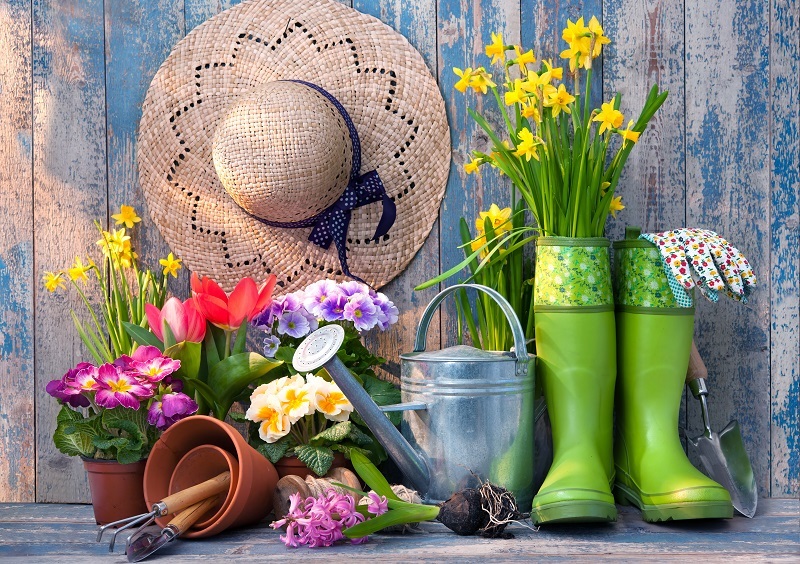The Ultimate Guide to Hydrangea Maintenance
Posted on 05/06/2025
The Ultimate Guide to Hydrangea Maintenance
Are you enchanted by the lush blooms of hydrangeas? These timeless garden favorites captivate with clusters of flowers in vibrant hues and offer visual appeal season after season. To enjoy their beauty year-round, proper hydrangea care is crucial. In this comprehensive guide, you'll find everything you need to nurture healthy, thriving hydrangeas--from planting tips to troubleshooting common issues.
Why Choose Hydrangeas for Your Garden?
Hydrangeas are renowned for their voluminous blossoms, versatility, and ability to brighten any garden landscape. Whether nestled against a fence, lining walkways, or showcased in containers, hydrangeas are suited to myriad settings. Popular for their easy elegance, these flowering shrubs can also adapt to sun or shade, making them an excellent choice for both novice and seasoned gardeners.
Top Reasons Hydrangeas Are Garden Favorites
- Long-lasting blooms from spring into fall
- Variety of colors, including pink, blue, purple, and white
- Low-maintenance once established
- Attract pollinators and beneficial insects
- Perfect for cut arrangements and drying

Essential Hydrangea Varieties and Their Unique Needs
Before diving into hydrangea maintenance, it's important to identify which type is growing in your garden. Each hydrangea group has distinct care requirements:
Common Hydrangea Types
- Bigleaf Hydrangea (Hydrangea macrophylla): Famous for their mophead or lacecap flowers, often in pink or blue. These favor moist, acidic soil and part shade.
- PeeGee or Panicle Hydrangea (Hydrangea paniculata): Boasting conical clusters of white blooms that age to pink. Tolerates full sun better than other types.
- Oakleaf Hydrangea (Hydrangea quercifolia): Recognizable by their oak-like foliage and white flowers, they thrive in shade and well-drained soils.
- Smooth Hydrangea (Hydrangea arborescens): Includes the famous 'Annabelle'. Prefers filtered sunlight and moist conditions.
- Climbing Hydrangea (Hydrangea anomala subsp. petiolaris): Ideal for vertical interest on walls or trellises. Needs support and tolerates shade.
Understanding your hydrangea type will ensure optimal care, from watering to pruning and beyond.
Planting Hydrangeas: Setting the Stage for Success
Proper planting lays the groundwork for healthy hydrangeas. Follow these steps to give your plants the best start:
Site Selection
- Sunlight: Most thrive in morning sun and afternoon shade. Panicle types withstand more sun.
- Soil: Hydrangeas favor fertile, well-drained soil rich in organic matter.
- Spacing: Account for mature size (typically 3-6 feet wide). Good air flow prevents disease.
How to Plant Hydrangeas
- Dig a hole twice as wide as the root ball but no deeper.
- Enrich the soil with compost or leaf mold.
- Gently place your hydrangea and backfill with amended soil, tamping lightly.
- Water deeply after planting.
- Add a 2-3 inch layer of mulch to retain moisture and suppress weeds.
For container-grown hydrangeas, ensure ample drainage and space for root growth. Water more frequently, especially in hot climates.
The Art of Watering Hydrangeas
Maintaining consistent moisture is vital for hydrangea care. Their shallow roots dry out quickly, making proper watering one of the most crucial aspects of hydrangea maintenance.
Hydration Tips for Healthy Blooms
- Deep water once or twice a week; daily during extreme heat.
- Morning is the best time to water, reducing evaporation and fungal risk.
- Use drip irrigation or soaker hoses to avoid wetting leaves.
- Monitor rain levels--hydrangeas need about 1 inch of water weekly.
- Mulch helps conserve moisture and regulate soil temperature.
Hydrangea Fertilizing for Robust Growth
Feeding hydrangeas supports healthy foliage and lush blooms. Understanding when and how much to fertilize prevents overfeeding, which can lead to fewer flowers.
Fertilizer Dos and Don'ts
- Apply balanced, slow-release fertilizer in early spring as new growth emerges.
- Avoid high-nitrogen formulas, which promote leaves at the expense of blooms.
- Acid-loving plant food can deepen blue flower color.
- Stop fertilizing in mid to late summer to prevent tender growth before winter.
Note: Always follow package instructions and adjust based on your soil test results.
The Secrets to Stunning Hydrangea Blooms
Did you know that hydrangea flower color is influenced by soil chemistry? The classic blue hydrangea derives its color from acidic conditions (pH below 6), while alkaline soils produce pink flowers.
How to Change Hydrangea Color
- For Blue Blooms: Add aluminum sulfate or organic matter like pine needles to lower soil pH.
- For Pink Blooms: Apply lime to your soil to raise pH levels.
Testing your soil annually will help you maintain your desired hydrangea flower color. However, not all varieties respond to pH changes--white hydrangeas, for instance, always remain white.
Pruning Hydrangeas: When and How
Knowing when to prune hydrangeas depends on their type. Incorrect pruning is a common reason for sparse blooms!
Quick Guide to Pruning Popular Hydrangea Types
- Bigleaf and Oakleaf Hydrangeas: Prune after flowering, typically in late summer. These bloom on old wood, so don't cut in spring or you'll lose that year's flowers.
- Panicle and Smooth Hydrangeas: Prune in late winter or early spring before new growth. These bloom on new wood, enabling harder pruning for shape or size control.
- Climbing Hydrangeas: Require little pruning. Remove damaged stems after flowering as needed.
When pruning, always use sanitized, sharp shears. Remove dead, diseased, or crossing branches to improve airflow and encourage healthier growth.
Protecting Hydrangeas from Pests and Diseases
With the right preventative care, you can easily protect hydrangeas from common threats:
Common Issues and Solutions
- Powdery Mildew & Leaf Spot: Prevent by providing room for air circulation and avoiding overhead watering. Treat with fungicidal sprays as needed.
- Aphids & Spider Mites: Wash off with a strong spray of water or use insecticidal soap.
- Slugs: Remove by hand or use bait traps.
- Deer: Consider fencing or repellents; some varieties like panicle hydrangeas are less appetizing to deer.
Regular inspections and prompt intervention are key to keeping your hydrangeas healthy and beautiful.
How to Prepare Hydrangeas for Winter
Proper winter care ensures your hydrangeas come back strong in spring. This is especially important in colder regions:
Winterization Steps
- Cease fertilizing by late summer.
- Water thoroughly in fall if the weather is dry.
- Apply a thick mulch layer (4-6 inches) around the base to insulate roots.
- For especially cold climates, cover with burlap or a frost cloth.
- Don't prune spring-blooming varieties in fall--wait until after they bloom next year.
*Remember:* Smooth and panicle hydrangeas are the most winter-hardy, but all benefit from some protection.
Hydrangea Maintenance Throughout the Year
Great hydrangea care is a year-round effort. Here's a seasonal care calendar to keep your plants thriving:
Spring
- Feed with balanced fertilizer as new growth appears.
- Remove winter mulch, prune if appropriate for your type.
- Inspect for winter damage and pests.
Summer
- Keep soil consistently moist, especially during dry spells.
- Deadhead spent flowers for a tidier appearance.
- Monitor regularly for pests and diseases.
Fall
- Enjoy autumn leaf color (oakleaf hydrangeas shine here).
- Cease fertilizing; begin winter preparations.
- Apply new mulch and remove any dead wood.
Winter
- Monitor for cold snaps and add extra protection if needed.
- Limit foot traffic near frozen or snow-covered plants.
Frequently Asked Questions About Hydrangea Maintenance
How often should I water my hydrangeas?
It depends on your local climate and soil, but aim for 1 inch of water per week, more during hot spells. Always check soil moisture and adjust accordingly.
Why are my hydrangea leaves turning yellow?
Yellow leaves may indicate overwatering, poor drainage, or nutrient deficiency. Test your soil and adjust care practices as needed.
My hydrangeas aren't blooming--what's wrong?
Common causes include improper pruning, cold damage, insufficient sunlight, or over-fertilizing. Review care guidelines and plant type to correct the issue.
Can I grow hydrangeas in pots?
Absolutely! Choose compact varieties, use quality container soil, provide ample drainage, and water more vigilantly. Protect pots in winter if needed.

Enhancing Your Garden with Hydrangeas
The classic charm and lush, voluminous flowers of hydrangeas bring any garden to life. With diligent hydrangea maintenance practices--from the right planting location to correct watering, fertilization, pruning, pest management, and winter protection--you'll enjoy these stunning shrubs for years to come.
Whether you're a beginner eager to nurture your first hydrangea or a veteran gardener perfecting your technique, these time-tested guidelines will help your hydrangeas thrive. Commit to consistent, attentive care, and soon you'll be rewarded with a profusion of exquisite blooms each season.
Conclusion: Grow Your Best Hydrangeas Ever!
Caring for hydrangeas doesn't have to be complicated. With a clear understanding of your garden environment and the distinct needs of your hydrangeas, you can confidently provide the right care at every stage of growth. Bookmark this Ultimate Guide to Hydrangea Maintenance and refer back throughout the year for tips, troubleshooting, and seasonal tasks.
Ready to get started? Grab your garden gloves, some quality mulch, and start nurturing the hydrangea of your dreams today!







